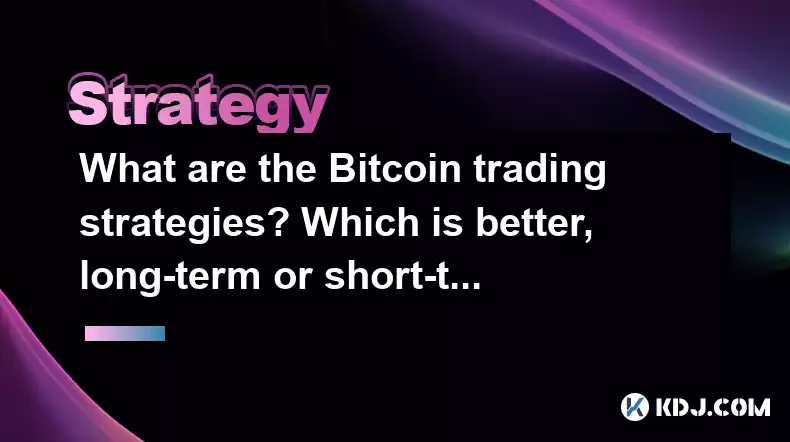-
 bitcoin
bitcoin $122025.899241 USD
-2.12% -
 ethereum
ethereum $4488.068729 USD
-4.11% -
 bnb
bnb $1315.348019 USD
8.65% -
 tether
tether $1.000457 USD
0.03% -
 xrp
xrp $2.875326 USD
-3.69% -
 solana
solana $222.043604 USD
-4.07% -
 usd-coin
usd-coin $0.999682 USD
0.00% -
 dogecoin
dogecoin $0.249887 USD
-5.62% -
 tron
tron $0.337379 USD
-2.59% -
 cardano
cardano $0.827763 USD
-5.06% -
 hyperliquid
hyperliquid $45.774531 USD
-2.43% -
 chainlink
chainlink $22.079309 USD
-5.87% -
 ethena-usde
ethena-usde $1.000156 USD
0.02% -
 sui
sui $3.482566 USD
-3.57% -
 stellar
stellar $0.386982 USD
-4.92%
What are the Bitcoin trading strategies? Which is better, long-term or short-term?
Bitcoin trading strategies include long-term holding for growth and short-term trading for quick profits, each with unique benefits and risks.
May 05, 2025 at 06:29 pm

Bitcoin trading strategies encompass a variety of approaches that traders use to maximize their returns in the cryptocurrency market. These strategies can broadly be categorized into long-term and short-term trading, each with its own set of advantages and challenges. In this article, we will delve into the specifics of both long-term and short-term Bitcoin trading strategies, examining their mechanisms, benefits, and potential pitfalls.
Long-Term Bitcoin Trading Strategy
Long-term trading, often referred to as 'HODLing,' involves holding onto Bitcoin for an extended period, typically months or years, with the expectation that its value will increase over time. This strategy is based on the belief in Bitcoin's long-term potential and its increasing adoption and acceptance as a legitimate form of currency and investment.
Benefits of Long-Term Trading
- Reduced Stress: Long-term trading eliminates the need to constantly monitor the market, reducing the stress associated with short-term fluctuations.
- Compounding Gains: By holding onto Bitcoin, traders can benefit from the compounding effect of its growth over time.
- Lower Transaction Costs: Since long-term traders trade less frequently, they incur fewer transaction fees.
Risks of Long-Term Trading
- Market Volatility: Bitcoin's price can be highly volatile, and long-term holders may need to weather significant dips in value.
- Opportunity Cost: Holding onto Bitcoin means missing out on potential gains from other investment opportunities.
How to Implement a Long-Term Trading Strategy
- Research and Analysis: Conduct thorough research on Bitcoin's fundamentals, its technology, and its adoption rate to make an informed decision about its long-term potential.
- Diversification: Consider diversifying your cryptocurrency portfolio to mitigate risk, but maintain a significant portion in Bitcoin if you believe in its long-term value.
- Patience: Be prepared to hold onto your Bitcoin for years, understanding that its value may fluctuate significantly in the short term.
Short-Term Bitcoin Trading Strategy
Short-term trading involves buying and selling Bitcoin within a shorter timeframe, ranging from minutes to days or weeks. This strategy aims to capitalize on the frequent price movements of Bitcoin, which can be influenced by market sentiment, news, and other short-term factors.
Benefits of Short-Term Trading
- Quick Profits: Short-term traders can potentially make quick profits by capitalizing on Bitcoin's price volatility.
- Flexibility: This strategy allows traders to adapt quickly to market changes and adjust their positions accordingly.
- Active Engagement: Short-term trading can be more engaging for traders who enjoy the thrill of the market.
Risks of Short-Term Trading
- High Stress: Constant monitoring of the market and quick decision-making can be stressful and time-consuming.
- Higher Transaction Costs: Frequent trading leads to higher transaction fees, which can eat into profits.
- Emotional Decision-Making: Short-term traders may be more susceptible to making impulsive decisions based on emotions rather than analysis.
How to Implement a Short-Term Trading Strategy
- Technical Analysis: Use technical analysis tools such as charts, indicators, and patterns to identify potential entry and exit points for trades.
- Risk Management: Implement strict risk management rules, such as setting stop-loss orders to limit potential losses.
- Stay Informed: Keep up-to-date with market news and events that could impact Bitcoin's price in the short term.
Comparing Long-Term and Short-Term Trading
When deciding between long-term and short-term trading, it's essential to consider your investment goals, risk tolerance, and the time you can dedicate to trading.
Investment Goals
- Long-Term Trading: If your goal is to benefit from Bitcoin's long-term growth and you are willing to hold onto it for years, long-term trading may be more suitable.
- Short-Term Trading: If you aim to make quick profits and are comfortable with the risks associated with frequent trading, short-term trading could be the better choice.
Risk Tolerance
- Long-Term Trading: This strategy is generally considered less risky, as it focuses on the overall trend rather than short-term fluctuations.
- Short-Term Trading: This approach involves higher risk due to the potential for significant losses from rapid price movements.
Time Commitment
- Long-Term Trading: Requires less time commitment, as you do not need to monitor the market constantly.
- Short-Term Trading: Demands a significant time investment, as you need to stay actively engaged with the market.
Choosing the Right Strategy for You
The choice between long-term and short-term trading ultimately depends on your individual circumstances and preferences. Both strategies have the potential to be profitable, but they cater to different types of traders.
Considerations for Choosing a Strategy
- Financial Goals: Evaluate your financial goals and how they align with the potential outcomes of each strategy.
- Risk Assessment: Assess your risk tolerance and how much volatility you are willing to endure.
- Time Availability: Consider the amount of time you can dedicate to trading and monitoring the market.
Implementing Your Chosen Strategy
Once you have decided on a trading strategy, it's crucial to implement it effectively to maximize your chances of success.
Steps for Long-Term Trading
- Set Up a Secure Wallet: Use a secure hardware or software wallet to store your Bitcoin safely.
- Allocate Funds: Decide how much of your investment portfolio you want to allocate to Bitcoin.
- Monitor Periodically: While long-term trading requires less frequent monitoring, it's still important to check on your investment periodically and stay informed about major developments in the cryptocurrency space.
Steps for Short-Term Trading
- Choose a Trading Platform: Select a reputable cryptocurrency exchange that offers the tools and features you need for short-term trading.
- Fund Your Account: Deposit funds into your trading account, ensuring you only invest what you can afford to lose.
- Develop a Trading Plan: Create a detailed trading plan that outlines your entry and exit points, risk management rules, and profit targets.
- Execute Trades: Use the platform's trading interface to buy and sell Bitcoin based on your trading plan.
- Monitor and Adjust: Continuously monitor the market and be prepared to adjust your trades based on new information and market conditions.
Frequently Asked Questions
Q1: Can I combine long-term and short-term trading strategies?Yes, it is possible to combine both strategies by allocating a portion of your portfolio to long-term holding and another portion to short-term trading. This approach can help you benefit from both the long-term growth potential of Bitcoin and the opportunities presented by short-term price movements.
Q2: How do taxes affect my Bitcoin trading strategy?Taxes can significantly impact your trading strategy, as profits from both long-term and short-term trading are subject to capital gains tax. Long-term capital gains are typically taxed at a lower rate than short-term gains, which may influence your decision on which strategy to use. It's advisable to consult with a tax professional to understand the specific tax implications for your situation.
Q3: What are some common mistakes to avoid in Bitcoin trading?Common mistakes in Bitcoin trading include trading without a plan, failing to manage risk effectively, letting emotions drive trading decisions, and not staying informed about market developments. To avoid these pitfalls, always have a clear trading plan, implement strict risk management rules, stay disciplined, and keep up-to-date with relevant news and analysis.
Q4: How can I improve my trading skills in the Bitcoin market?To improve your trading skills, consider the following steps:
- Education: Continuously educate yourself about Bitcoin and the broader cryptocurrency market through books, courses, and reputable online resources.
- Practice: Use a demo trading account to practice your strategies without risking real money.
- Analysis: Develop your skills in both technical and fundamental analysis to make more informed trading decisions.
- Community: Engage with the cryptocurrency community through forums, social media, and trading groups to learn from other traders' experiences and insights.
Disclaimer:info@kdj.com
The information provided is not trading advice. kdj.com does not assume any responsibility for any investments made based on the information provided in this article. Cryptocurrencies are highly volatile and it is highly recommended that you invest with caution after thorough research!
If you believe that the content used on this website infringes your copyright, please contact us immediately (info@kdj.com) and we will delete it promptly.
- BlockDAG, DOGE, HYPE Sponsorship: Crypto Trends Shaping 2025
- 2025-10-01 00:25:13
- Deutsche Börse and Circle: A StableCoin Adoption Powerhouse in Europe
- 2025-10-01 00:25:13
- BlockDAG's Presale Buzz: Is It the Crypto to Watch in October 2025?
- 2025-10-01 00:30:13
- Bitcoin, Crypto, and IQ: When Genius Meets Digital Gold?
- 2025-10-01 00:30:13
- Stablecoins, American Innovation, and Wallet Tokens: The Next Frontier
- 2025-10-01 00:35:12
- NBU, Coins, and Crypto in Ukraine: A New Yorker's Take
- 2025-10-01 00:45:14
Related knowledge

Practical parameter settings for a Bitcoin multi-timeframe moving average system
Sep 18,2025 at 10:54pm
Optimizing Timeframe Combinations for Bitcoin Trading1. Selecting appropriate timeframes is crucial when building a multi-timeframe moving average sys...

How can I filter out false breakouts in Dogecoin high-frequency trading?
Sep 22,2025 at 01:00am
Understanding False Breakouts in Dogecoin Trading1. A false breakout occurs when Dogecoin's price appears to move beyond a defined support or resistan...

Techniques for identifying tops and bottoms in the Bitcoin on-chain NVT model
Sep 20,2025 at 07:54pm
Understanding the NVT Model in Bitcoin Analysis1. The Network Value to Transactions (NVT) ratio is often described as the 'P/E ratio' of the cryptocur...

What does the surge in open interest in Bitcoincoin futures mean?
Sep 20,2025 at 11:18pm
Understanding the Surge in Dogecoin Futures Open Interest1. A surge in open interest within Dogecoin futures indicates a growing number of active cont...

How can I use the Ethereum USDT premium to gauge market sentiment?
Sep 18,2025 at 11:55pm
Understanding the Ethereum USDT Premium1. The Ethereum USDT premium refers to the price difference between USDT (Tether) traded on Ethereum-based plat...

What should I do if Ethereum staking yields decline?
Sep 20,2025 at 06:18am
Understanding the Causes Behind Declining Ethereum Staking Yields1. The Ethereum network transitioned to a proof-of-stake consensus mechanism with the...

Practical parameter settings for a Bitcoin multi-timeframe moving average system
Sep 18,2025 at 10:54pm
Optimizing Timeframe Combinations for Bitcoin Trading1. Selecting appropriate timeframes is crucial when building a multi-timeframe moving average sys...

How can I filter out false breakouts in Dogecoin high-frequency trading?
Sep 22,2025 at 01:00am
Understanding False Breakouts in Dogecoin Trading1. A false breakout occurs when Dogecoin's price appears to move beyond a defined support or resistan...

Techniques for identifying tops and bottoms in the Bitcoin on-chain NVT model
Sep 20,2025 at 07:54pm
Understanding the NVT Model in Bitcoin Analysis1. The Network Value to Transactions (NVT) ratio is often described as the 'P/E ratio' of the cryptocur...

What does the surge in open interest in Bitcoincoin futures mean?
Sep 20,2025 at 11:18pm
Understanding the Surge in Dogecoin Futures Open Interest1. A surge in open interest within Dogecoin futures indicates a growing number of active cont...

How can I use the Ethereum USDT premium to gauge market sentiment?
Sep 18,2025 at 11:55pm
Understanding the Ethereum USDT Premium1. The Ethereum USDT premium refers to the price difference between USDT (Tether) traded on Ethereum-based plat...

What should I do if Ethereum staking yields decline?
Sep 20,2025 at 06:18am
Understanding the Causes Behind Declining Ethereum Staking Yields1. The Ethereum network transitioned to a proof-of-stake consensus mechanism with the...
See all articles










































































